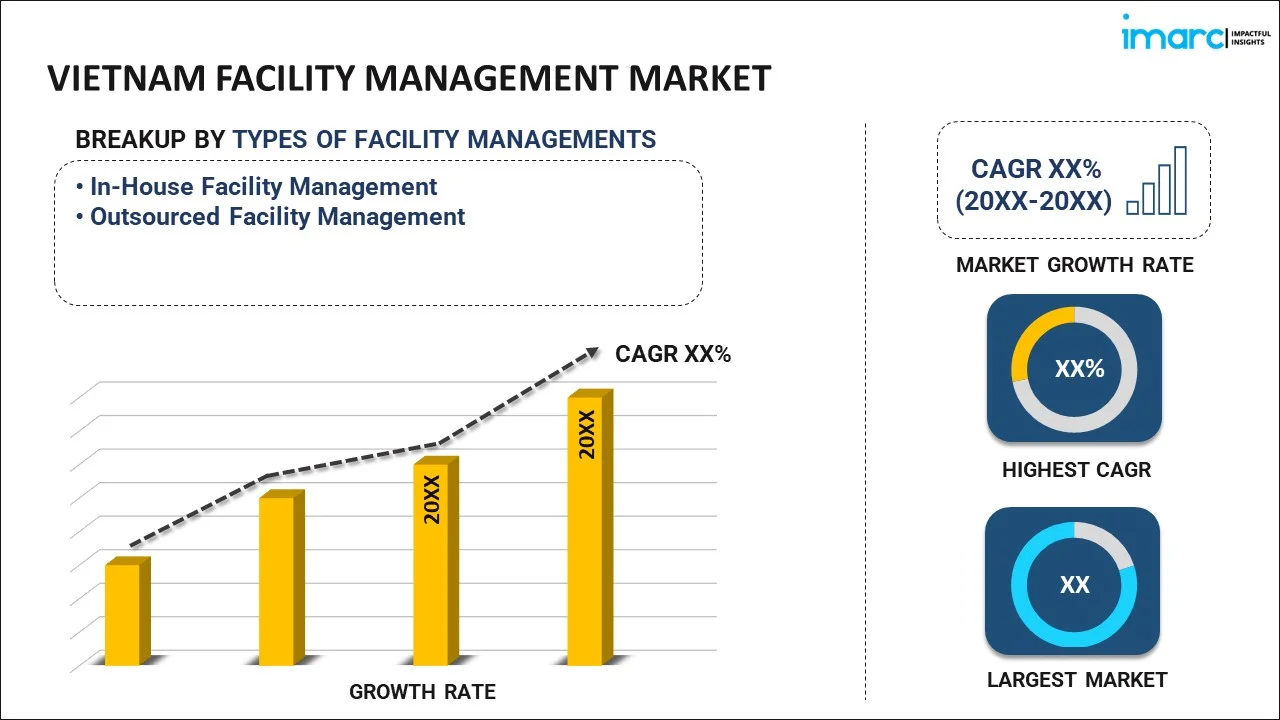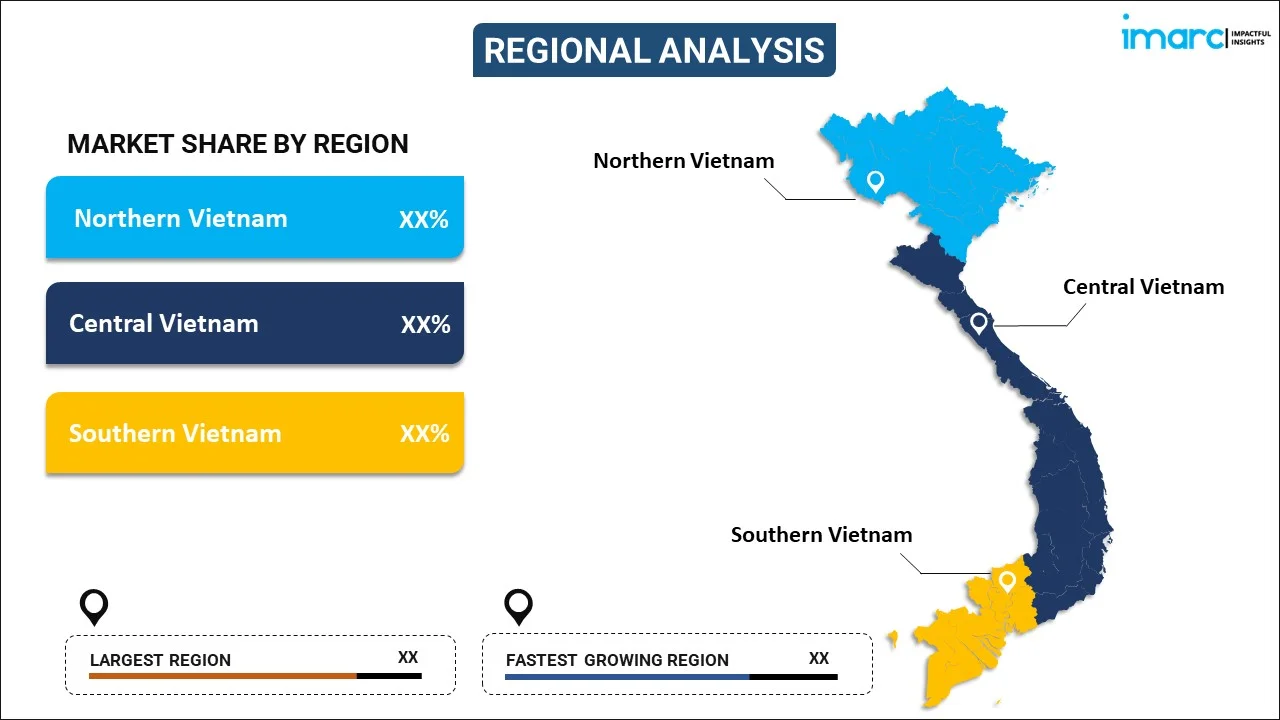
Vietnam Facility Management Market Report by Type of Facility Management (In-House Facility Management, Outsourced Facility Management), Offerings (Hard FM, Soft FM), End User (Commercial, Institutional, Public/Infrastructure, Industrial, and Others), and Region 2025-2033
Market Overview:
Vietnam facility management market size reached USD 325.9 Million in 2024. Looking forward, IMARC Group expects the market to reach USD 662.4 Million by 2033, exhibiting a growth rate (CAGR) of 7.5% during 2025-2033. The rapid expansion of the real estate sector, considerable rise in the construction of office spaces, factories, and residential complexes, and the increasing incorporation of Internet of Things (IoT) and automation represent some of the key factors driving the market.
|
Report Attribute
|
Key Statistics
|
|---|---|
|
Base Year
|
2024
|
|
Forecast Years
|
2025-2033
|
|
Historical Years
|
2019-2024
|
| Market Size in 2024 | USD 325.9 Million |
| Market Forecast in 2033 | USD 662.4 Million |
| Market Growth Rate 2025-2033 | 7.5% |
Facility management (FM) refers to a multidisciplinary function that ensures the smooth operation of an organization’s-built environment. It encompasses a wide range of activities and responsibilities, including maintenance, utilities management, space optimization, and health and safety protocols. The ultimate goal of facility management is to create an efficient and safe working environment that supports the core activities of an organization. Facility managers utilize a variety of tools and technologies, such as building management systems and software platforms, to monitor, manage, and improve the performance of facilities. It plays a pivotal role in asset management and long-term planning, helping organizations maximize the lifespan and functionality of their facilities. Whether it's an office building, a hospital, or a university campus, effective facility management ensures that all systems operate cohesively and that resources are used efficiently. Additionally, it enhances operational effectiveness and also contributes to sustainability goals by promoting energy efficiency and waste reduction.
Vietnam Facility Management Market Trends:
The market in Vietnam is primarily driven by the expanding real estate sector, particularly in commercial and industrial segments. Moreover, the rise in the construction of office spaces, factories, and residential complexes has created a demand for efficient facility management services to maintain these structures. In addition to physical maintenance, facility management also encompasses other essential services, including security, waste management, and energy optimization, thus broadening its scope and appeal in the Vietnamese market. Apart from this, government policies are also creating a positive market outlook since the Vietnamese government is progressively recognizing the importance of sustainable building practices and has implemented a set of regulations that make facility management integral to real estate development. In line with this, the increasing focus on green initiatives and smart cities further necessitates sophisticated facility management services that are environmentally sustainable and technologically advanced. Furthermore, the increasing influx of foreign companies setting up operations in Vietnam has raised the bar for facility management standards. These multinational corporations often bring global best practices with them, creating a demand for high-quality facility management services that meet international standards. Besides, the incorporation of smart technologies, such as the Internet of Things (IoT), automation, and data analytics in facility management has made it possible to monitor and control building functions remotely, thereby making operations more efficient. This technological adoption is providing an impetus to the market. Moreover, several leading players are becoming more inclined to outsource facility management tasks to focus on their core operations. This trend has led to an increase in specialized facility management firms entering the market, thereby creating a competitive landscape that encourages innovation and price optimization.
Vietnam Facility Management Market Segmentation:
IMARC Group provides an analysis of the key trends in each segment of the market, along with forecasts at the country level for 2025-2033. Our report has categorized the market based on type of facility management, offerings, and end user.
Type of Facility Management Insights:

- In-House Facility Management
- Outsourced Facility Management
- Single FM
- Bundled FM
- Integrated FM
The report has provided a detailed breakup and analysis of the market based on the type of facility management. This includes In-house facility management, outsourced facility management (single FM, bundled FM, and integrated FM).
Offerings Insights:
- Hard FM
- Soft FM
A detailed breakup and analysis of the market based on the offerings have also been provided in the report. This includes hard FM and soft FM.
End User Insights:
- Commercial
- Institutional
- Public/Infrastructure
- Industrial
- Others
The report has provided a detailed breakup and analysis of the market based on the end user. This includes commercial, institutional, public/infrastructure, industrial, and others.
Regional Insights:

- Northern Vietnam
- Central Vietnam
- Southern Vietnam
The report has also provided a comprehensive analysis of all the major regional markets, which include Northern Vietnam, Central Vietnam, and Southern Vietnam.
Competitive Landscape:
The market research report has also provided a comprehensive analysis of the competitive landscape in the market. Competitive analysis such as market structure, key player positioning, top winning strategies, competitive dashboard, and company evaluation quadrant has been covered in the report. Also, detailed profiles of all major companies have been provided.
Vietnam Facility Management Market Report Coverage:
| Report Features | Details |
|---|---|
| Base Year of the Analysis | 2024 |
| Historical Period | 2019-2024 |
| Forecast Period | 2025-2033 |
| Units | Million USD |
| Scope of the Report | Exploration of Historical and Forecast Trends, Industry Catalysts and Challenges, Segment-Wise Historical and Predictive Market Assessment:
|
| Types of Facility Managements Covered |
|
| Offerings Covered | Hard FM, Soft FM |
| End Users Covered | Commercial, Institutional, Public/Infrastructure, Industrial, Others |
| Regions Covered | Northern Vietnam, Central Vietnam, Southern Vietnam |
| Customization Scope | 10% Free Customization |
| Post-Sale Analyst Support | 10-12 Weeks |
| Delivery Format | PDF and Excel through Email (We can also provide the editable version of the report in PPT/Word format on special request) |
Key Questions Answered in This Report:
- How has the Vietnam facility management market performed so far and how will it perform in the coming years?
- What has been the impact of COVID-19 on the Vietnam facility management market?
- What is the breakup of the Vietnam facility management market on the basis of type of facility management?
- What is the breakup of the Vietnam facility management market on the basis of offerings?
- What is the breakup of the Vietnam facility management market on the basis of end user?
- What are the various stages in the value chain of the Vietnam facility management market?
- What are the key driving factors and challenges in the Vietnam facility management?
- What is the structure of the Vietnam facility management market and who are the key players?
- What is the degree of competition in the Vietnam facility management market?
Key Benefits for Stakeholders:
- IMARC’s industry report offers a comprehensive quantitative analysis of various market segments, historical and current market trends, market forecasts, and dynamics of the Vietnam facility management market from 2019-2033.
- The research report provides the latest information on the market drivers, challenges, and opportunities in the Vietnam facility management market.
- Porter's five forces analysis assist stakeholders in assessing the impact of new entrants, competitive rivalry, supplier power, buyer power, and the threat of substitution. It helps stakeholders to analyze the level of competition within the Vietnam facility management industry and its attractiveness.
- Competitive landscape allows stakeholders to understand their competitive environment and provides an insight into the current positions of key players in the market.
Need more help?
- Speak to our experienced analysts for insights on the current market scenarios.
- Include additional segments and countries to customize the report as per your requirement.
- Gain an unparalleled competitive advantage in your domain by understanding how to utilize the report and positively impacting your operations and revenue.
- For further assistance, please connect with our analysts.
 Inquire Before Buying
Inquire Before Buying
 Speak to an Analyst
Speak to an Analyst
 Request Brochure
Request Brochure
 Request Customization
Request Customization




.webp)




.webp)












